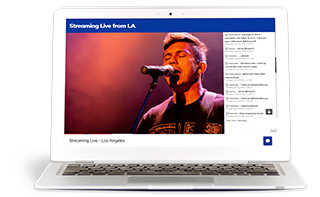 Seemingly without warning, professional events, conferences and in-person meetings across the globe have transformed events into virtual and hybrid environments. No one knows how long it will be before in-person events are back to full capacity. On the positive side we all have quickly learned new skills, specifically adapting to technology to replace our physical worlds. Event organizers are lucky, virtual event technology was primed for this pivotal opportunity to shine. Good timing too, as many believe that virtual and hybrid events are here to stay.
Seemingly without warning, professional events, conferences and in-person meetings across the globe have transformed events into virtual and hybrid environments. No one knows how long it will be before in-person events are back to full capacity. On the positive side we all have quickly learned new skills, specifically adapting to technology to replace our physical worlds. Event organizers are lucky, virtual event technology was primed for this pivotal opportunity to shine. Good timing too, as many believe that virtual and hybrid events are here to stay.
What is a virtual event?
A virtual event is similar to an in-person event where people gather to connect with others of similar interests, to share ideas or consume educational content. In contrast to in-person events that take place at a physical venue, virtual events provide a destination for the gathering in an online environment.
Hybrid events offer a combination of both physical and online destinations for the event. Attendees have the option to join the live event at the venue, or they can choose to attend virtually. It’s the best of both worlds, as it just requires adding a camera crew to the existing event then creating the virtual environment. Many organizers are seeing higher attendance to their events by offering this flexibility between physical and virtual environments.
Before setting out to plan your virtual or hybrid event, start by defining the goals and objectives. There are many different underlying reasons to host an event, from engaging a community, growing a brand, creating an educational experience, to generating leads for a product. Clearly defined goals will help you design your content delivery regardless of whether your event is held in a physical or virtual environment.
Virtual event solutions have evolved to meet the goals for just about any type of event. So, here’s the rundown of the different formats and how they might best meet your objectives:
 Live Stream:
Live Stream:
(just like it sounds) Live streaming is where your content is broadcast live as it is taking place – giving virtual attendees the experience in real-time. They can provide exclusive access to content as it is released to the general public. Live streams are great for building excitement for well anticipated events like a live concert, product launch reveals or sporting events. Live streaming is ideal for audiences who don’t have the option to travel to the location or when the venue capacity is full.
Ideal for: alternatives to in-person events, product launches, entertainment experiences, live games or sporting events.
Tip: Consider how you want to deliver this experience, broadcasting from a studio (moderator in a news room setting) or live from a location at the event. Explore different camera angles to add to the visual interest or switch it up with commentary from speakers at various locations.
Webinar:
 A format where attendees tune in virtually to view content presented by one or multiple hosts. Webinars are typically single sessions that can be broadcast live or on-demand. They are well suited for content that is delivered to a large remote audience and presentations that don’t require much interaction. Speakers can broadcast from remote locations, connecting online or through mobile devices.
A format where attendees tune in virtually to view content presented by one or multiple hosts. Webinars are typically single sessions that can be broadcast live or on-demand. They are well suited for content that is delivered to a large remote audience and presentations that don’t require much interaction. Speakers can broadcast from remote locations, connecting online or through mobile devices.
Ideal for: e-learning events, training sessions, sales kick-offs, user conferences
Tip: Offer real-time Q&A sessions to allow attendees to ask the speaker questions. Have a moderator review questions as they come in, to eliminate duplicates and prioritize.
 Panels and Forums:
Panels and Forums:
This format involves a group of people gathered to discuss a topic in front of the audience. Typically, the entire group is visible on screen at any given time, whether they are all together ‘on stage’ or as individual headshots on screen. Ideally, the technology should highlight the person who is speaking so the audience knows which speaker is commenting at any given time. Although this format is intended for a discussion among a set group, organizers should allow the audience to send questions to the group.
Ideal for: business, or educational conferences, industry discussions, fan meet & greets, interviews and debates.
Tip: Consider a variety of speakers before selecting the panel. Specifically look for participants with diverse views and perspectives to stimulate thought-provoking discussion. Panel discussions work well with a moderator to keep the session on track and ask the right questions to drive the discussion.
Breakout Sessions:
 These are a series of sessions that separate attendees into smaller groups for more detailed discussions. Sessions can be used to segment attendees and enable them to interact and discuss specific areas of content learned at the event. Attendees typically choose the sessions to attend based on individual interest resulting in higher levels of engagement.
These are a series of sessions that separate attendees into smaller groups for more detailed discussions. Sessions can be used to segment attendees and enable them to interact and discuss specific areas of content learned at the event. Attendees typically choose the sessions to attend based on individual interest resulting in higher levels of engagement.
Ideal for: e-learning events, workshops, brainstorming, role play, discussions, networking
Tip: Breakout sessions allow you to address a variety of topics to a targeted audience. Consider recording these sessions and offering a playback of these sessions on your website for attendees to explore at their convenience.

Keep in mind for hybrid events, the majority of the content will be consumed by both in-person and virtual attendees, so any interactive activities may come off differently in the virtual environment. Create an audience engagement strategy for remote attendees with alternative ways for them to interact such as breakout streams, virtual networking and polls.
Organizers and attendees around the world are looking forward to resuming in-person events, but the outlook for the event industry is uncertain at this moment. For the time being, everyone from event organizers, businesses to entertainers and sports teams are quickly adapting to the new normal for events by adding virtual alternatives to in-person attendance. Fortunately, there are a number of virtual event platforms and high-tech tools that are prepared to help create engaging virtual and hybrid events.
|
Recommended Read: Translating in-person events into virtual environments is a big challenge for event organizers. Here’s our list of the top 10 tips for planning virtual and hybrid events.

|



 A format where attendees tune in virtually to view content presented by one or multiple hosts. Webinars are typically single sessions that can be broadcast live or on-demand. They are well suited for content that is delivered to a large remote audience and presentations that don’t require much interaction. Speakers can broadcast from remote locations, connecting online or through mobile devices.
A format where attendees tune in virtually to view content presented by one or multiple hosts. Webinars are typically single sessions that can be broadcast live or on-demand. They are well suited for content that is delivered to a large remote audience and presentations that don’t require much interaction. Speakers can broadcast from remote locations, connecting online or through mobile devices.  Panels and Forums:
Panels and Forums:  These are a series of sessions that separate attendees into smaller groups for more detailed discussions. Sessions can be used to segment attendees and enable them to interact and discuss specific areas of content learned at the event. Attendees typically choose the sessions to attend based on individual interest resulting in higher levels of engagement.
These are a series of sessions that separate attendees into smaller groups for more detailed discussions. Sessions can be used to segment attendees and enable them to interact and discuss specific areas of content learned at the event. Attendees typically choose the sessions to attend based on individual interest resulting in higher levels of engagement.

